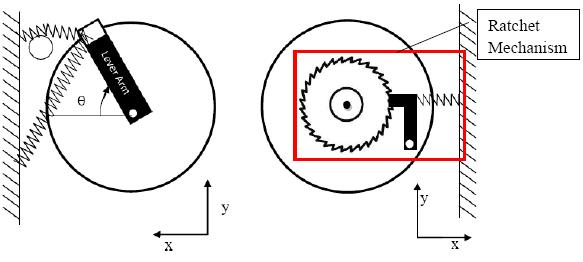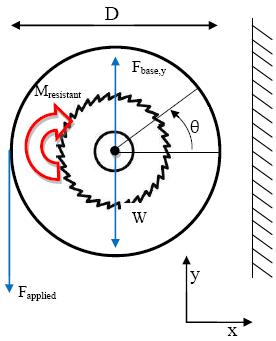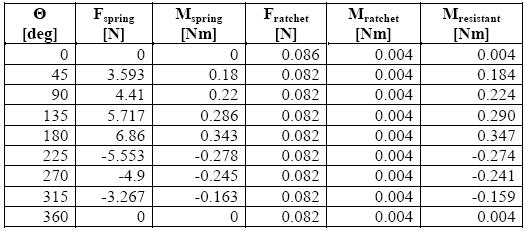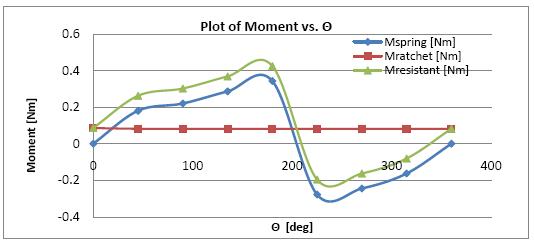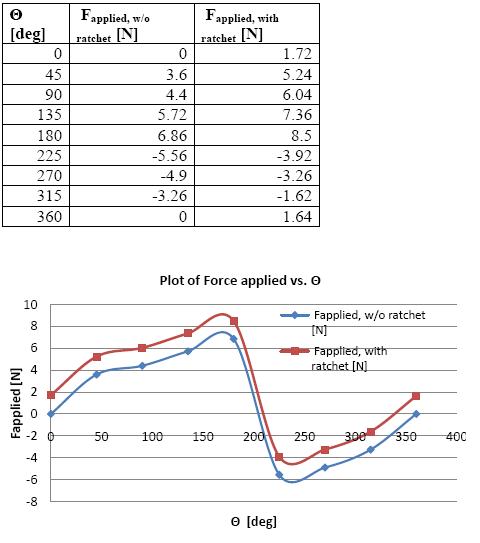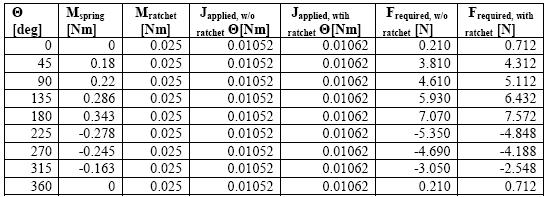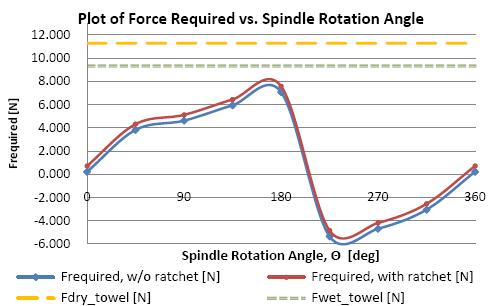Paper towel dispenser innovation
From DDL Wiki
(→Engineering Analysis) |
|||
| Line 162: | Line 162: | ||
== Team Member Roles == | == Team Member Roles == | ||
| - | Chang Keun Jung - | + | Chang Keun Jung - Mechanical Analysis |
Nishan Kulatilaka - | Nishan Kulatilaka - | ||
Revision as of 11:02, 5 December 2009
Mechanical Analysis
In our new paper towel dispenser, we incorporated a ratchet mechanism to prevent spindle from turning more than needed due to its inertia and causing paper towel to be rolled back in. For engineering analysis, we calculated and investigated to compare the effect of the additional inertia of the ratchet as well as the new resistance moment it will provide. First, we varied rotation angle of spindle and performed static analysis to measure force required for users to pull a paper towel with the original paper towel dispenser and with our new design. Then we assumed the average time it takes for a person to pull a paper towel to be 1 sec, and performed dynamic analysis of systems to find out required pulling force with and without ratchet mechanism.
Left view (left) and right view of spindle(right) with ratchet mechanism indicated by red box
Free Body Diagram
Simplied Free body diagram
Where:
D = diameter of spindle = 0.1m
Θ = angle displacement of spindle from initial state
W = weight of the spindle and ratchet gear
Fbase,y = force applied by axle of the base to the spindle in y-axis
Fapplied = force applied by user by pulling paper towel
Mresistant = Mspring + Mratchet
Mspring = moment from lever arm springs on the left side of spindle(varies with θ, angle of rotation of spindle, see Table 1)
Mratchet = moment from ratchet mechanism (moment due to friction force between ratchet gear and pawl, normal force being ratchet spring force and reaction force from axle of the base)
Determination of Mspring and Mratchet
Our group realized that determining Mspring and Mratchet from calculations of actual spring forces, dimensions, and friction forces is inefficient, and also inaccurate. Thus, we tested the actual model at different angles, incremented theta by 45 degrees, and reported forces to obtain Mspring and Mratchet values. To find force, we attached a reference spring to the end of sheet of paper towel and pulled until it reaches certain angle and stays at equilibrium. Then we measure the stretch of spring to find out the force. We applied the same method is used for both of Mspring and Mratchet, but we isolated the two values from each other and tested them separately.
Calculation of Mspring and Mratchet
References spring constant, k = 163.3 N/m
Initial length of reference spring constant, Linitial = 0.023 m
Fspring, i = k ∆xi = (163.33)∆xi N where ∆ xi = Lengthspring,i - Linitial = (Lengthspring,i - 0.023) m
Mspring, i = (D/2) Fspring, i = 0.05 Fspring, i Nm , where i = 0, 45°, 90°, …315°, 360 ° (eq.1)
Summary of results
The difference between Mspring and Mratchet is that unlike Mspring, Mratchet does not depend on angle of rotation. We found that Mratceht is relatively small compared to Mspring (approx. 2% of Mspring). Therefore we believe that adding ratchet mechanism would not cause a huge difference.
Table of resistant forces, moments at different angles of rotation
Resistant moments at different angles of rotation
Static Analysis
In order for the system to be static, sum of forces in all directions and sum of all moments should equal to zero.
Solving Force Applied without Ratchet
∑Fy = 0 => Fbase,y = W + Fapplied
∑Fx = 0: The thin paper towel guide (part 21) cancels forces in x-direction, no matter in what angle user pulls the paper towel.
∑M = 0 at the center of the spindle,
- Mspring + Fapplied(D/2) = 0 => Fapplied = (2/D)(Mspring) (eq.2)
Solving Force Applied with Ratchet
Simlarly, ∑M = 0 at the center of the spindle,
-Mratchet - Mspring + Fapplied(D/2) = 0 => Fapplied = (2/D)(Mratchet + Mspring) (eq.3)
Summary of results
Using eq.2 and eq.3 we calculated F applied with and without ratchet mechanism. As expected, although system with ratchet mechanism requires more force to be applied, it is not significant enough.
Table of Force applied at different angles of rotation at static state
Force applied at different angles of rotation at static state
Dynamic Analysis
In our dynamic system, sum of forces will equal to zero but the sum of moments would not equal to zero since the spindle will rotate at some angular velocity. In order to analyze this system, we need to figure out inertia of spindle and angular acceleration.
Solving Moment of Inertia
We calculated both the moment of inertia of the spindle and the spindle with the ratchet, assuming spindle as a hollow tube with radius of 5cm, and mass of 0.335 kg and ratchet gear as a disk with radius of 3cm and mass of 0.067 kg,
Jspindle = mspindlerspindle2 = (0.335 kg)(0.10 m/2)2 = 0.0008375 kg-m2
Jspindle, with ratchet = mspindlerspindle2 +1/2 mratchet rratchet2 = (0.335 )(0.05)2 + 1/2(0.067) (0.05)2 = 0.00084504 kg-m2
Solving Angular Acceleration
We first assumed time it takes for user to pull a paper towel is 0.5 s and the angular acceleration of spindle to be some constant value since it
Assume constant θ ̈=a and tpull = 0.5 s
Integrating θ ̈ with respect to t, ∫θ̈dt=∫a dt => θ=at+c1 (c1=0, since θ=0 at t=0) => θ̇=at
Integrating θ ̇ with respect to t, ∫θ̇dt=∫at dt => θ=(at2)/2+ c2 (c2=0, since θ=0 at t=0) => θ=(at2)/2
Since a pull cycle(2π) takes 0.5 s, θ=2π=(a(0.5s)2)/2 => a= (2π×2)/(0.5s)2 => a=50.27 rad/s2
Solving Force Applied without Ratchet for this angular acceleration
∑M=-Jθ̈= Mspring,i - Fapplied,i D/2
=> Fapplied,i = 2/D ( Mspring,i+ J θ ̈ ) (eq.4)
Solving Force Applied with Ratchet for this angular acceleration
∑M=-Jθ ̈= Mratchet,i + Mspring,i + - Fapplied,i D/2
=> Fapplied,i= 2/D (Mratchet,i + Mspring,i + J θ ̈ ) (eq.5)
Summary of result
Using eq.4 and eq.5 we calculated F applied with and without ratchet mechanism. As expected, although system with ratchet mechanism requires more force to be applied, it is not significant enough. Table of Force applied at different angles of rotation at dynamic state
Force applied at different angles of rotation at dynamic state
Conclusion
Adding ratchet mechanism increases moment of inertia, and force required for user to pull the paper towel in both static and dynamic state. However, this increase is insignificant because average human pulling force with two hands for male ranges from 310-370N and for female ranges from 70-180N. In addition, the required force in the new model does not exceed the amount of forces to break paper dry and wet towels. In both designs, the required forces maximized at when spindle is half way (180 degrees from initial position) of whole turn, and the values were found out to be 7.070N for regular design and 7.572N for our design. From experiment we found forces needed to break paper towel when it is dry to be 11.27N (Fdry_towel) and wet to be 9.31N (Fwet_towel). With our model, users need to pull dry paper towel less than in 0.219 sec and wet paper less than in 0.294 sec in order to get paper tower get ripped, but we consider these to be extreme cases, and thus our design seems to be practical for normal uses.
Team Member Roles
Chang Keun Jung - Mechanical Analysis
Nishan Kulatilaka -
James Li-Yang Lee -
Eric Totong -
References
1. W. Karwowski, International encyclopedia of ergonomics and human factors, volume 1, NW: CRC Press, 2006, page 500.
<references/>
